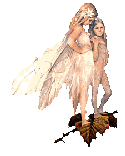|
|
|


Sylphs, also known as
Windsingers, are elemental air spirits claiming both Greek and
Egyptian ancestry. As a whole, this miniature race is very
beautiful. They are long-lived, reaching hundreds of years in age,
yet they never seem to become old. Like other elementals, they
possess the ability to shapeshift and may assume human form.
Typically residing on mountaintops, they possess a hierarchy system,
with their leader Paralda occupying the highest mountain of Earth.
Kind of nature, they are most helpful with wishes involving air,
though they will assist with any positive desire. In addition, they
are associated with mental development and one of their functions is
to inspire human creativity.

Originating in Shetland
and the Orkney Islands, and possibly the Upper Hebrides they are
most likely derived from legends of trolls in Scandinavia. The trows
(rhyming with row) possess many traits similar to those of their
northern brethren. They fear sunlight, though they are only frozen in
place until dawn rather than turned to stone as are trolls.
Once the sun has set, they are free to return to their underground homes.
Among their other names are creepers and nightstealers, as trows
have been known to kidnap human babies from cribs, leaving a
changeling in the place of the child. Fiddlers have also been nabbed
to play for the trowish revels. Some fiddle tunes are even
accredited to Shetland's trows. (The name sea-trow, I should note,
typically denotes a selkie, rather than the trows we discuss here.)
The legends of trows typically describe them as squat, round, and
misshapen faeries lacking legs. Movement is achieved by bouncing about
on their bottoms like rubber balls. They are not necessarily wicked
in nature, but they are mischievous and delight in hiding things from
people under the cover of darkness.
Phookas

An Irish Goblin, the
Phooka probably had his roots in Scandinavia before being
brought to Wales and Ireland. His Nordic name is Kornbock (which prefers a goat
body) and Welsh call him Bookha or Bwca (which typically has a pig or horse
body).
In Ireland the Phooka typically chooses a horse body, however he is a shape
shifter and sometimes becomes a goat, a bull, a dog, or an eagle (among other
beasts). His head is that of a human male. They are pranksters, like most
goblins, and appear to weary travelers as docile ponies. Once their victim has
climbed upon aboard, the phooka takes the hapless rider on a wild ride
across the wettest and most loamy country before depositing him in ditch or
tossing him headlong into the mire. His eagle form has also lended itself
to a similar trick.
Phookas are pack animals and frequent fights occur among the vicious creatures.
The Irish believe that should the sun shine though it be raining, the Phooka
will be abroad that night. In Ireland, the Phooka never enters human houses,
however in Wales the Booka sneak have taken their cue from Santa Claus and sneak
in through the chimney. This poses particular dangers because the species
adores human babies and are always looking for one to steal.
Aside from babysnatching, they wreck havoc by destroying crops, specifically
claiming any crop not harvested by Samhain. A farmer who dares to cut any crops
after that date is likely to receive retribution in the form of a dead herd
animals (the Irish say mysteriously dead cows have been pooked, at term which
likely grew from Phooka). In particular, the Phooka loves potatoes and swipes
them from untended fields at night. Between Midsummer and Samhain humans are
safe from the Phooka's tricks, as they are believed to go into hibernation for a
time.
Fachan

The Fachan, or Peg-Leg-Jack
as he is sometimes known because of his single leg, originated in
Scotland. Matching his single leg, all of his features are singular.
He possesses one head, one eye, one arm, one leg, one toe, one finger
and so forth, which are all perfectly centered on a body covered in
hair and feathers. Its coloring was pitch black, aside from a dark
blue mane of feathers which ruffled as a prelude to an attack. So
fearsome was its appearance, that the mere sight of the Fachan was
credited with causing heart-attacks.
The armament of the Fachan (sometimes spelled Fachen or Fachin)
was a single spiked club. He uses this club to chase away all livings
things. Indeed, he is a particularly spiteful faery and is most
jealous of the gift of flight he was denied despite his feathery
crown. He can be found on the highest Scottish mountains, though why
you would want to bother, I would rather not know.
Unimplemented ISML Tag: TYPE=
